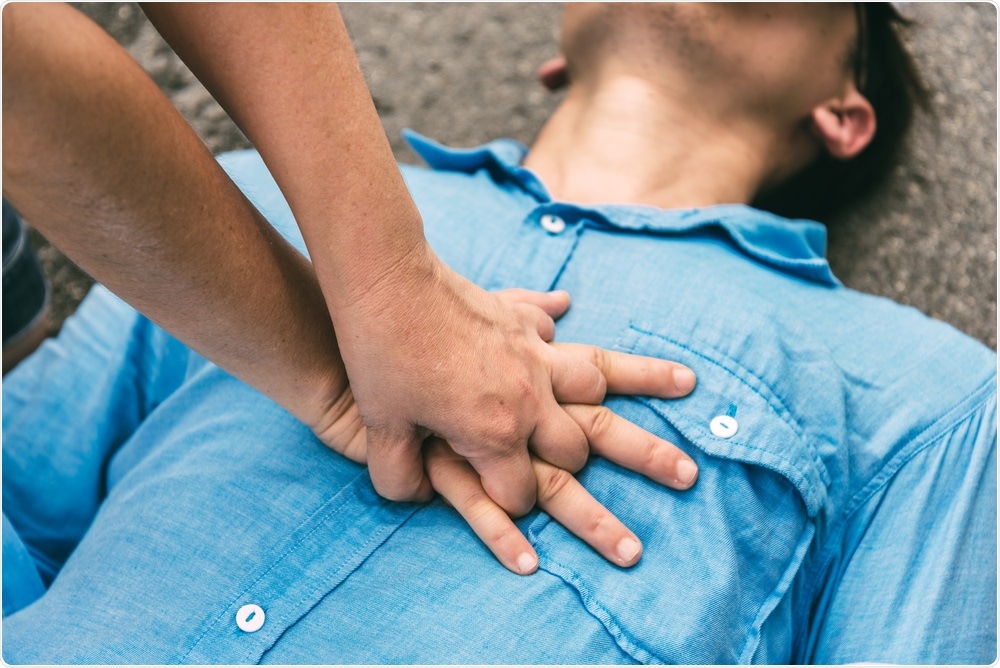An international study reviewed methods of cardiopulmonary resuscitation (CPR) in an attempt to answer the question: is there a ‘best’ combination of frequency and depth of chest compression that will provide optimal results in terms of survival without brain damage following out-of-hospital emergency treatment for a cardiac arrest?
The findings, published in the journal JAMA Cardiology, show that the best results are seen when CPR is begun and maintained for five minutes at about 107 compressions a minute to a depth of 2 inches (4.7 cm).
 SPK Lifestyle Stock Photo | Shutterstock
SPK Lifestyle Stock Photo | Shutterstock
This remains the same across all ages and both sexes, irrespective of the underlying cardiac rhythm, and whether or not any airway-securing device was used at this time. The use of adjunctive treatment did offer significantly greater survival benefits but only if this rate-depth combination was optimal.
The outcome, in this case, is judged by the recovery of neurological function in the survivor following CPR for a cardiac arrest. This study showed that performing CPR at 80% to 100% of this ideal combination resulted in a 6% rate of survival with intact brain activity, compared to 4% when these criteria were not followed.
This is a small percentage but when viewed against the context of the 300 000 cardiac arrests that occur every year out of a hospital, it means saving thousands of lives more than is possible now. This is sufficient motivation to spur the adoption of the target CPR combination globally.
The current study is remarkable for presenting its data using a graphical tool called a contour map, which shows the best chance for survival with intact neurological function at the hottest point.
Improving survival rates
Previous studies have also tried to identify the best depth of chest compression and have demonstrated that chest compressions of 100 to 120 a minute could improve survival rates and lower the risk of neural complications. These studies provided independent ‘best target’ ranges for better outcomes.
However, in addition to the frequency of which compressions should be given, the depth of compression is also important.
The researchers used previous studies covering compression depth and frequency in men, women, people of different ages and people who had waited a shorter or longer amount of time to receive CPR following a cardiac arrest. Once these factors had been accounted for, the researchers came up with their new guidelines.
Calling the study results “critical new knowledge,” researcher Paul Pepe said:
The findings here not only emphasize the importance of quality CPR performance, but they will likely help paramedics and others on the frontlines save many more lives.”
Paul Pepe, Co-Author
The study used data on CPR carried out on over 3600 people who had a cardiac arrest outside of the hospital, using an electronic device called the impedance threshold device (ITD) that reduces the pressure in the chest and improves the return of venous blood to the heart.
This was the first multicenter trial to use this tool. The first-responders were taught to apply the ITD either by face mask or by advanced airway with simultaneous chest compression and ventilation, as recommended by the latest American Heart Association guidelines.
These include 80-100 chest compressions a minute, a depth of 4-6 cm, and 10 positive-pressure breaths per minute, to achieve about 600 mL tidal volume.
The study was supported by the Resuscitation Outcomes Consortium (ROC), who provided standard resuscitation data retrieved from Emergency Medical Services (EMS) offered through 150 agencies spanning the USA and Canada.
The findings will now need to be confirmed by other studies. In addition, they should be explored in other EMS systems outside of the USA and Canada to establish their universal validity, and when the use of other devices or procedures, or of mechanical CPR, is envisaged.
Other areas to be explored include the possibility of improving outcome in arrhythmias that don’t respond to defibrillation by slower compressions, or reducing the depth of compression in older patients.
Journal reference:
Sue Duval, Paul E. Pepe, Tom P. Aufderheide, Jeffrey M. Goodloe, Guillaume Debaty, José Labarère, Atsushi Sugiyama, & Demetris Yannopoulos. (2019). Optimal combination of compression rate and depth during cardiopulmonary resuscitation for functionally favorable survival. JAMA Cardiology. doi:10.1001/jamacardio.2019.2717.